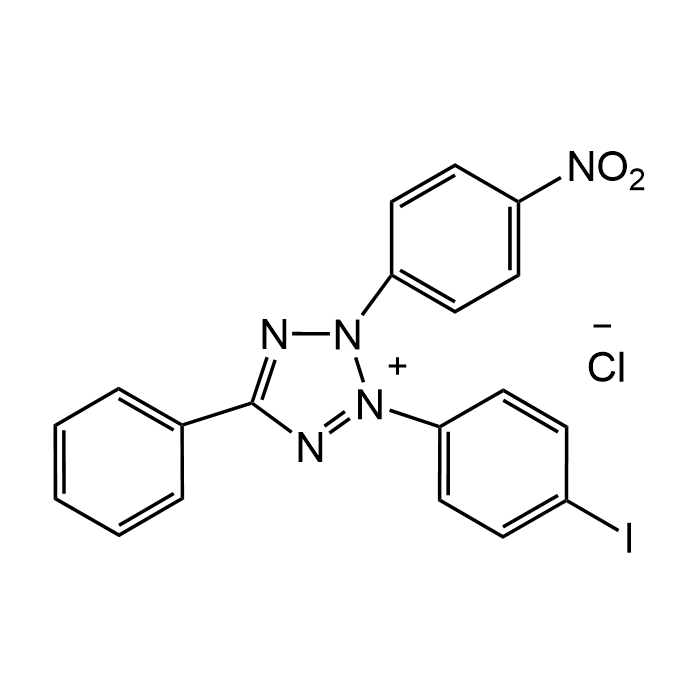Cookie Policy: This site uses cookies to improve your experience. You can find out more about our use of cookies in our Privacy Policy. By continuing to browse this site you agree to our use of cookies.
Chemodex
Iodonitrotetrazolium chloride

| Product Details | |
|---|---|
| Synonyms | p-Iodonitrotetrazolium Violet; INT; 2-(4-Iodophenyl)-3-(4-nitrophenyl)-5-phenyl-2H-tetrazolium chloride; NSC 27620 |
| Product Type | Chemical |
| Properties | |
| Formula | C19H13IN5O2 . Cl |
| MW | 505.7 |
| CAS | 146-68-9 |
| Source/Host Chemicals | Synthetic |
| Purity Chemicals | ≥97% (TLC) |
| Appearance | White, dark yellow to dark orange powder. |
| Solubility | Soluble in methanol (10mg/ml), ethanol (30mg/ml) or water (10mg/ml). |
| Identity | Determined by 1H-NMR. |
| Declaration | Manufactured by Chemodex. |
| Other Product Data |
Click here for Original Manufacturer Product Datasheet |
| InChi Key | HFHUFZBIRLRHCK-UHFFFAOYSA-M |
| Smiles | IC(C=C1)=CC=C1[N+]2=NC(C3=CC=CC=C3)=NN2C4=CC=C([N+]([O-])=O)C=C4.[Cl-] |
| Shipping and Handling | |
| Shipping | AMBIENT |
| Short Term Storage | +20°C |
| Long Term Storage | +4°C |
| Handling Advice | Protect from light and moisture. |
| Use/Stability | Stable for at least 2 years after receipt when stored at +4°C. |
| Documents | |
| Product Specification Sheet | |
| Datasheet |
 Download PDF Download PDF |
Iodonitrotetrazolium chloride (INT) is used as an indicator dye. It is reduced by cellular activity to a red-colored formazan precipitate and used as a vital dye or indicator of cellular redox activity. INT is used in cell viability assays. Living cells with active metabolic processes can reduce INT to the red formazan. INT can also be used as an indicator of cellular redox activity. The reduction process reflects the cells' ability to transfer electrons, providing insights into their metabolic state. Reduction commonly results from the activity of dehydrogenases, although non-enzymatic electron transfer reactions can occur in the presence of an intermediate electron acceptor. This property of INT is used in various diagnostic assays (hematology/). INT is commonly used to measure the respiratory activity of microorganisms in a variety of contexts. The maximum absorption wavelength (λmax) of INT (unreduced) is ~248nm. The reduced formazan (red) has a λmax ~490-520nm.
(1) J.D. Green & H.T. Narahara; J. Histochem. Cytochem. 28, 408 (1980) | (2) J.J. Podczasy & R. Wei; BBRC 150, 1294 (1988) | (3) M. Kamburova, et al.; Talanta 40, 707 (1993) | (4) P. Munujos, et al.; Anal. Biochem. 212, 506 (1993) | (5) M.V. Berridge, et al.; Biotechnol. Ann. Rev. 11, 127 (2005) | (6) R.W. Sabnis; Handbook of biological dyes and stains (2010) | (7) Y. Liu, et al.; Infect. Drug Resist. 13, 2593 (2020) | (8) E. Song, et al.; ACS Appl. Mater. Interfaces 14, 38153 (2022)





